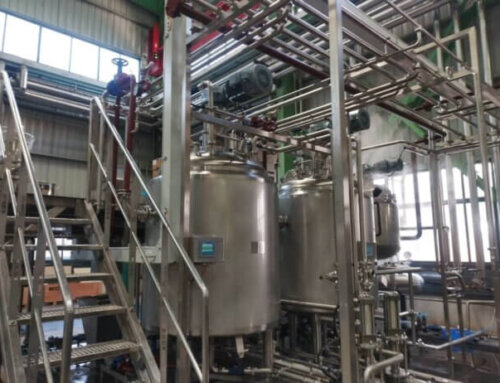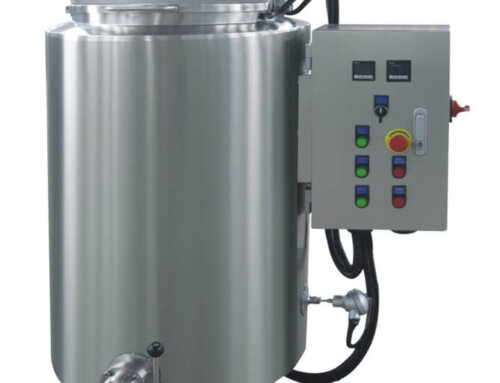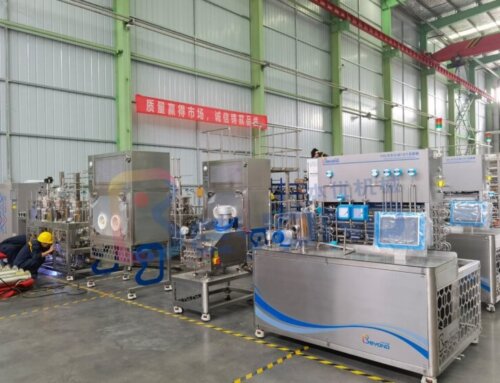Liquid Egg Pasteurization Process Description
1. Egg products are processed and convenient forms of eggs for commercial, foodservice and home use. These are refrigerated liquid products, frozen products, dried and specialty products. No matter the end products are egg yolk, egg white, or egg powder, when processing, the liquid egg pasteurization is an essential and core process for producing the egg products. Pasteurized liquid egg products represent around 70% of total egg products, it is necessary for microbiological safety in liquid eggs.
2. Eggs are rich in high-quality protein, fat, cholesterol and other micronutrients, so after breaking the eggs by the egg beater, the egg liquid will be polluted by bacterial. In order not to damage the quality of the egg liquid, we use a plate cooler to cool the egg liquid to 4°C and store it in a heat preservation tank, so that in a low-temperature environment, bacteria are not easy to multiply too quickly, and prepare for the subsequent pasteurization of the egg liquid.
3. Because the heating range of egg yolk and egg white is different, we suggest that if the customer produces egg white and egg yolk separately, the egg white and egg yolk need to be pasteurized separately.
4. Liquid egg pasteurization process is gentle, the heating temperature and time need to control precisely to make sure the liquid egg two phenomena do not occur:
–Insufficient pasteurization results in pathogenic microorganisms remaining in the egg liquid.
–Or the pasteurization strength is too high, causing protein denaturation or the products fouling on the plates or tubes.
5. Liquid egg pasteurization is a processing measure to completely eliminate pathogenic bacteria in egg liquid and to reduce the number of miscellaneous bacteria to the greatest extent by heating while keeping the nutrient components of egg liquid from being lost to the greatest extent. The protein in the egg liquid is easily denatured and coagulated. It is necessary to select suitable pasteurization conditions.
6. Liquid egg after proper pasteurization, the shelf life can reach 15 days-30 days in aseptic containers and stored in -4℃ to -1℃.
7. We provide turnkey project liquid egg products production plant include egg yolk production, egg white production, whole liquid egg production, egg powder production and mayonnaise production.
Microorganisms in Egg Liquid
E. coli is most commonly found in unsterilized egg liquid, and Salmonella and Staphylococcus are also frequently detected. The detection rate of Salmonella contaminated by chicken manure is several times higher than that of clean eggshells. Therefore, we need to disinfect and soak the eggs at the first step of the processing of egg liquid. The egg liquid collection tank following the egg breaker/beater has the highest frequency of detecting microorganisms.
There are about 900 kinds of Salmonella, the most suitable survival temperature is 36.6-37.6℃, and the lowest survival temperature is 10℃, so the temperature of egg liquid should be kept below 5℃. Salmonella grows slowly in the egg white and quickly grows in the yolk. The most suitable pH value for growth is 6.5-7.5, and it cannot increase if the PH value is higher than 9 or lower than 4.5. Salmonella is the most important cause of food poisoning in egg liquid, so it must be killed.
Liquid Egg Pasteurization Process Introduction
Pasteurization of whole liquid eggs
The pasteurization temperature of the whole egg liquid is 4℃heating to 60℃and holding for 3.5 minutes and cooling to 4℃. After pasteurization under such conditions, the functional characteristics of the whole egg liquid in food ingredients can generally be maintained, and pathogenic bacteria can be all killed and reduced the number of bacteria in the egg liquid.
Pasteurization of egg yolk
The main pathogenic bacteria in egg yolk is Salmonella. The heat resistance of this bacteria in egg yolk is higher than that in egg white and whole egg liquid. This is because the pH value of egg yolk is lower. Salmonella is not sensitive to heat in low pH environment, and the dry matter content in egg yolk is relatively high. Therefore, the pasteurization of egg yolks is higher than that of whole eggs and egg whites. In egg yolk pasteurization, the most common pasteurization method is heating egg yolk from 4℃to 61°C and holding the temperature for 3 minutes and cooling to 4℃.
Pasteurization of egg white
The protein in egg white is more susceptible to heat denaturation, causing loss of functional properties, so pasteurization of egg white requires more gentle treatment. You can heat the egg white to 56°C and hold the temperature for 3 minutes then cool down to 4℃.
Liquid Egg Pasteurization Equipment Introduction
Batch pasteurization tank
The batch pasteurization tank system is generally suitable for processing egg liquids (300LPH-500LPH) with a small production capacity. This type of pasteurization system mainly includes two pasteurization tanks, a plate heat exchanger and pipe valves. The egg liquid sterilization system has low investment, simple equipment structure and easy operation. However, the pasteurization temperature control is not precise and the efficiency is low. The principle of pasteurization is to heat hot water through a plate heat exchanger, and then pass the hot water into the sterilization tank to sterilize the egg liquid.

Liquid egg plate or tube pasteurizer
For customers who have sufficient budget and want to produce high-quality egg liquid products, we recommend using a plate or tube pasteurizer to process egg liquid. The pasteurization machine has high working efficiency, and the pasteurization temperature and time are controlled by PLC instruments with high accuracy. After the egg liquid is pasteurized, the chance of being contaminated again is also small. It is suitable for egg liquid processing production lines of 300LPH or more.





